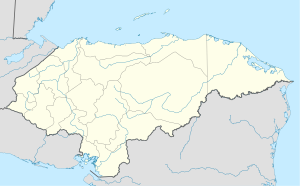Yoro, with a population of 27,460, is the capital city of the Yoro Department of Honduras and the municipal seat of Yoro Municipality. It is notable for a local event known as Lluvia de Peces, where it is claimed that strong storms make fish fall from the sky.
La Esperanza is the capital city and a municipality of the same name of the department of Intibucá, Honduras. La Esperanza is famous for having the coolest climate in Honduras. It is considered the heart of the Ruta Lenca, a region of Lenca ethnic influence that spans Honduras from Santa Rosa de Copan to Choluteca. Sites on the Lenca Trail have been designated by the government and United Nations development in order to encourage more cultural tourism, and help create new markets for the traditional crafts, such as pottery, practiced by the Lenca, in order to preserve their culture.
La Paz is the capital city of the La Paz Department of Honduras. The town, founded in 1792, has a population of 32,450.

Santa Bárbara, with a population of 30,690, is the capital city of the Santa Bárbara Department of Honduras and the municipal seat of Santa Bárbara Municipality.

El Progreso is a city, with a population of 120,600, and a municipality located in the Honduran department of Yoro.
Colomoncagua is a municipality in the Honduran department of Intibucá.
Masaguara is a municipality in the Honduran department of Intibucá.
San Juan, Intibucá lies in the western highlands of Honduras between Gracias and La Esperanza.
Chinacla is a municipality in the Honduran department of La Paz.
Guajiquiro is a municipality in the Honduran department of La Paz.
San Antonio del Norte is a municipality in the Honduran department of La Paz.
San José is a municipality in the Honduran department of La Paz.

San Marcos de Caiquín is a municipality in the Honduran department of Lempira created November 4, 1994.

San Sebastián is a municipality in the Honduran department of Lempira.
El Negrito is a town, with an urban population of 13,260 (2023), and a municipality in the department of Yoro, Honduras.
Belén Gualcho is a municipality in the Honduran department of Ocotepeque. This small village founded in 1715 is a jewel in the middle of the Honduran mountains, located in the department of Ocotepeque and close to Gracias and San Sebastian to the south. The highlights of the village are the colonial Church of La Trinidad and Sunday Market where the Lenca people come to sale and get basic supplies. In 1871, it was listed as the head of the Curato de Gualcho, later it was called Belén de Copán or Belén de Occidente; on September 2, 1907, it became part of the Ocotepeque Department, calling it Belén de Ocotepeque and on February 15, 1922 it was called Belén Gualcho, belonging to the Sensenti district. Its name according to the Mexica spelling means "House of the oaks", and in Lenca language it means "Place of many waters"
San Marcos is a town, with a population of 6,836, and a municipality in the Honduran department of Ocotepeque.
Quimistán is a town, with a population of 6,270, and a municipality in Santa Bárbara Department of Honduras. The largest town of the municipality is Pinalejo, with a population of 6,478.
San Luis is a town, with a population of 5,857, and a municipality in the Honduran department of Santa Bárbara.

Intibucá is a city, with a population of 28,220, and a municipality in the department of Intibucá, Honduras. The urban area of Intibucá is an important transit and commercial site in the South-West region of Honduras. Located 1,850 meters above sea level, Intibucá has a cool and often foggy climate, hence the nickname "La ciudad del manto blanco". Potato production, celebrated by the annual Festival de la Papa, is the principal basis of the economy for the municipality.






